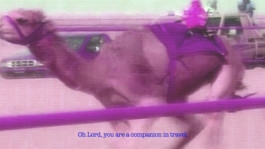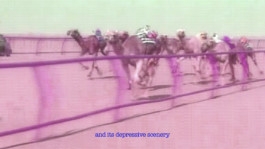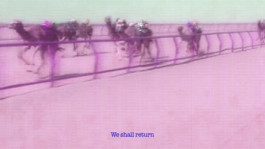







2014, Single channel video, 2.5 minutes
Travel Prayer
“Coming in at just under three minutes, Travel Prayer, 2014, one of Monira Al Qadiri’s videos, is brief, but its focus is precise: The artist distills into this short span the momentous collisions between tradition and technology, desert culture and global capital, that increasingly define the Gulf states. The work consists of a tightly framed view of a camel race that the artist recorded from a television broadcast, slowed down just enough to turn a gallop into a glide. The found footage has a grainy, almost nostalgic quality to it, which the artist has emphasized by tinting the sky teal, only to counter such softness by toning the racetrack, its fence, and the animals with a bright, otherworldly fuchsia filter. Al Qadiri also composed an electronic score to accentuate the movement—a few notes forming a wistful lullaby—and paired it with a recording of a voice melodically reciting a prayer dedicated to safe travel.The first line—“Sublime is the one who created this for us”—underscores a subtle cruelty permeating the scene: The camels are outfitted with remote controlled whipping machines, which their owners operate while trailing the race in SUVs.
Travel Prayer is a study of progress in its most ambiguous sense: a step forward that is also a step back. The camels are an example of an ageold tradition tragically caught up in the accelerated development that has propelled the Gulf since the second half of the past century. The camels’ robotic appendages were, in fact, invented in response to a 2002 law banning what had essentially become a trade in child camel jockeys conducted with Pakistan, India, Bangladesh, and Sri Lanka. And the impact of such fraught transformations extends to Gulf residents themselves: Al Qadiri has referred to Travel Prayer as a selfportrait, suggesting that the historical and ethical issues raised by the work are as intertwined with individual identity as they are with the broader culture and politics of the region.”
Article by Stephanie Bailey, Artforum May 2015








2014, Single channel video, 2.5 minutes
Travel Prayer
“Coming in at just under three minutes, Travel Prayer, 2014, one of Monira Al Qadiri’s videos, is brief, but its focus is precise: The artist distills into this short span the momentous collisions between tradition and technology, desert culture and global capital, that increasingly define the Gulf states. The work consists of a tightly framed view of a camel race that the artist recorded from a television broadcast, slowed down just enough to turn a gallop into a glide. The found footage has a grainy, almost nostalgic quality to it, which the artist has emphasized by tinting the sky teal, only to counter such softness by toning the racetrack, its fence, and the animals with a bright, otherworldly fuchsia filter. Al Qadiri also composed an electronic score to accentuate the movement—a few notes forming a wistful lullaby—and paired it with a recording of a voice melodically reciting a prayer dedicated to safe travel.The first line—“Sublime is the one who created this for us”—underscores a subtle cruelty permeating the scene: The camels are outfitted with remote controlled whipping machines, which their owners operate while trailing the race in SUVs.
Travel Prayer is a study of progress in its most ambiguous sense: a step forward that is also a step back. The camels are an example of an ageold tradition tragically caught up in the accelerated development that has propelled the Gulf since the second half of the past century. The camels’ robotic appendages were, in fact, invented in response to a 2002 law banning what had essentially become a trade in child camel jockeys conducted with Pakistan, India, Bangladesh, and Sri Lanka. And the impact of such fraught transformations extends to Gulf residents themselves: Al Qadiri has referred to Travel Prayer as a selfportrait, suggesting that the historical and ethical issues raised by the work are as intertwined with individual identity as they are with the broader culture and politics of the region.”
Article by Stephanie Bailey, Artforum May 2015